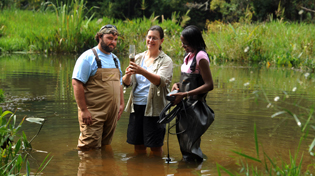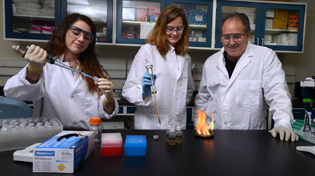Wetlands Research Laboratory
The Wetlands Research Laboratory (WRL, Bldg. 83, a 3,500 square feet facility) is an analytical arm of CEDB.

The WRL is State of Florida Certified for environmental water analysis (Lab ID: E71969), conforming to the standards set out by the National Environmental Laboratory Accreditation Conference as adopted into Chapter 64E-1 of the Florida Administrative Code. The laboratory complies with full chain of custody sample storage and handling practices, and can be reached at (850)-857-6096 or at wetlandslab@uwf.edu.
DOH Bur of Labs Certification (PDF)
Certified Methods:
- Non-Potable Water (PDF)
- Drinking Water (PDF)

The WRL is equipped with pH, salinity, and conductivity meters; a Bran and Luebbe AutoAnalyzer 3 nutrient analyzer with autosampler; a Lachat Quikchem FIA with IC; ovens; incubators; a muffle furnace; analytical and top-loading balances; two autoclaves; water baths; block digesters; sonicator; research-grade (Leica) compound microscope; a Varian SPECTRAA 220FS flame atomic absorption spectrometer (AAS); and a Varian SPECTRAA 220Z Zeeman furnace AAS.
Two Agilent 5890 GCs equipped with flame ionization detectors, electron capture detectors and thermal conductivity detectors. The GCs are equipped with capillary column injection systems and Megabore column injections systems. Both GCs are fitted with 100 sample autosamplers and are controlled by a ChemStation data system.
ThermoFisher/Finnigan 4500 mass spectrometer with positive and negative ion modes and mass range of 1000 daltons. The instrument is equipped for both electron ionization and chemical ionization as well as fast atom bombardment ionization. Samples can be introduced by heat direct probe or direct exposure probe.
ThermoFisher/Finnigan Incos 50 GC/MS system. Capable of both positive and negative ion modes with a mass range of 650 daltons. The instrument is equipped for both electron ionization or chemical ionization. The GC is an Agilent 5890 fitted for capillary columns and a 100 sample autosampler.
An Agilent 1050 liquid chromatograph. The system includes a quaternary solvent system with degasser and column heater. The unit is fitted with an autosampler and variable wavelength UV detector.


